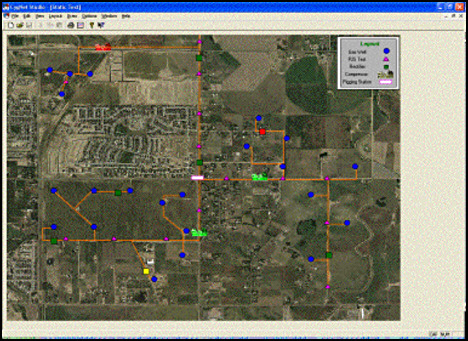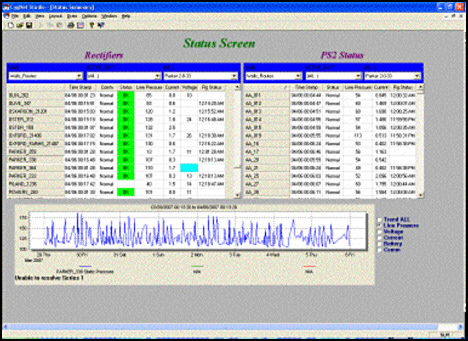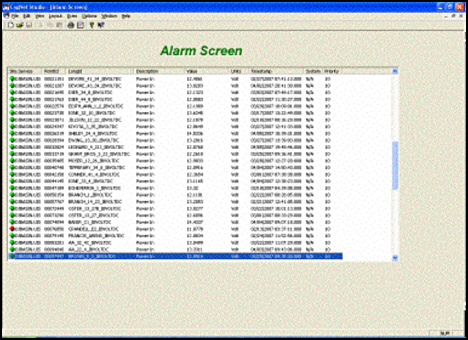Recent unfortunate pipeline news events have made corrosion and cathodic protection front page news. The U.S. Congress and several states have initiated legislation directed specifically toward cathodic protection practices. The energy and pipeline companies are now wrestling to meet new, stricter state and federal pipeline integrity requirements while trying to control operating costs. Many companies are looking to new technologies and automation for answers. Some companies have used cell phone technologies for remote pipeline monitoring but their ever-changing nature has left the companies scrambling to stay ahead of telemetry obsolescence. Leading edge isn't always best: effective answers to critical issues affecting public safety often involve a combination of both old and new technology.
Aging Infrastructure
Nearly 2.3 million miles of buried steel pipeline now are in place—and aging—and roughly 70% of North America's energy supply is running through them (Figure 1). Pipeline integrity management has never been more important. To meet rising energy demands, new pipeline construction is occurring at a record pace.
 Figure 1. A map of the national natural gas pipeline |
Remote pipeline cathodic protection systems installed in the 1920s were implemented to protect these assets and to extend their useful lifespan. All metal structures placed in the ground will corrode as electrical charges pass between the metal and any form of ground contaminant (e.g., moisture), oxidizing the metal. Cathodic protection rectifiers provide a charge on the metal pipeline that "rectifies" the charges being passed, preventing the oxidation. These remote systems have traditionally been maintained by a technician going to a site to take readings and make adjustments. Wireless communication devices can replace this expensive and time-consuming process.
However, maintaining these remote systems is onerous, expensive, and difficult to optimize using older technologies and practices. Many of the major domestic transportation pipelines are close to 50 years old, raising national concerns about their long-term integrity and ability to serve the public safely or economically. One analyst speculates that pipeline integrity issues alone could drive energy prices higher by 27%.
Legislation—the Stick and the Pending Carrot
As pipeline operations have grown throughout North America, so have federal and state regulations governing the industry. The Pipeline Safety Improvement Act was passed in December 2002 and the Pipeline Inspection, Protection, Enforcement and Safety Act in 2006. Both acts serve to illustrate growing awareness of the problem and to educate the industry on pipeline operation best practices.
In March 2007, Bill H.R. 1770, the Corrosion Prevention Act of 2007 was introduced into the U.S. House of Representatives. This bill provides a tax credit to companies that invest in corrosion control and mitigation technologies. H.R. 1770 directly benefits nearly all owners and operating companies that must protect their assets and businesses from the impact of corrosion and that must help protect the environment and public safety from the harmful effects of corroding assets.
Technology Obsolescence
The changing communication technologies have soured some energy and pipeline companies from implementing widespread remote monitoring of pipeline facilities. The recent switch from analog cellular technologies to the now diverse offering of digital protocols required the wholesale change of thousands of cell phone modems costing the consumer tens, and possibly hundreds, of thousands of dollars. Many companies were hit again for cell phone modem conversion when many communication providers switched to different digital protocols, once again costing tens of thousands of dollars. Understandably, companies are concerned about the long-term stability of their communications services provider.
In addition, homeland security issues are leading more companies to reconsider farming out their communication systems outside the firewall. Many already have or are considering implementing their own communication system in an effort to boost network protection of vital company assets.
First Step in the Right Direction
A supervisory control and data acquisition (SCADA) system is the backbone to a wireless data communication network that sends and receives data from secure, central IT networks to companies' remote field assets, such as pipelines, compressor sites, pigging stations, pump stations, wellhead controls, tank-farm units, rectifiers, pipe-to-soil test stations, city gates, measurement stations, isolation points, and aboveground appurtenances (Figure 2).
   Figure 2. An overhead view of an example system with system management software screenshots |
For operational and security reasons, many energy and pipeline companies already own and operate their own SCADA networks. Leveraging their existing capital investment in SCADA by extending the data communication network further out in the field, they can add cathodic protection equipment to the measurement points, compressors, and pumping stations they already monitor remotely.
For companies that do not currently own a SCADA system, small-scale cathodic protection SCADA systems are implemented with minimal investment in readily available software, off-the-shelf PCs, and the services of internal or external local integration companies. SCADA systems were first implemented back in the 1960s and were typically mainframe-based and therefore, very centralized. They also used custom communication protocols and were very expensive to implement. Now, SCADA systems are commonly available for as little as a few thousand dollars. They use open communication protocols such as Modbus, and implementation is made simple through standardization and by using templates of basic pipeline operations.
Finish the Job
With an effective SCADA system in place, remote cathodic protection monitoring field devices can be installed easily and cost-effectively on rectifiers, pipe-to-soil test stations, pigging stations, and pressure monitoring points. Cathodic protection monitoring field devices automatically collect and report mission critical, corrosion prevention data and transmit data back to the central SCADA system via wireless modems, often using an existing radio network. Extending the companies' existing SCADA and radio infrastructure leverages this investment further and automates the operational function of cathodic protection monitoring. Many of the same reasons SCADA was justified in the first place years ago still hold true for pipeline integrity automation as well:
- Increase public, company, and operator safety
- Reduce operator windshield time, road usage, vehicle maintenance, risk exposure, and general liability insurance
- Reduce operating costs; operators spend time on vital company functions rather than driving around collecting data
- Provide automated and timely regulatory reporting
- Offer timely operational data retrieval, with enhanced automated trending capabilities, alarming functionality, and automated operator notification
- Enhance cathodic protection performance; the systems get worked on in a timely fashion when problems arise
 Figure 3. An example installation showing a technician placing the protective tower and solar panel |
To avoid system failures it's important to select the right radio for your application. The radio must meet the communication range requirements for your system, handle interference that may be present, and capture the data accurately.
Each cathodic protection monitoring radio also can serve as a data communication repeater site. Adding new radios extends the radio networks' ability to reach further into remote areas, thus enabling additional monitoring of remote compressors, energy fields, oil and gas wells, gas plants, pump stations, etc.
Many energy and pipeline companies already own other similar radio products and the new cathodic protection monitoring radios easily integrate into these existing systems.
Pipeline Integrity Automation Now
Automation of pipeline integrity management has never been more needed, more available or more affordable. New remote monitoring technologies, when merged with existing company assets, solve a difficult and expensive task of corrosion prevention monitoring by extending the useful lifespan of buried pipelines.
